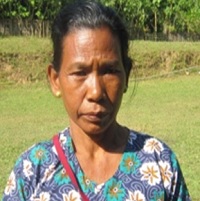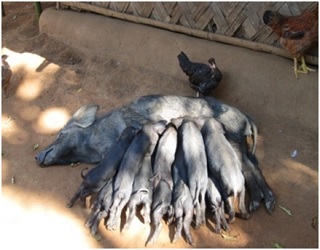Income generation from pig (Ghungroo) production.
Background
Pig plays an important role in the tribal economy of the NE Hills States as the bulk and preferential diet for them is pork. Almost every tribal household in the region rear at least one or two pigs in backyard, but still a wide gap exists between the demand and availability of pork. The main reason for insufficiency in pork production is that the pigs reared by the farmers are mostly of nondescript type, whose productivity is relatively poor and hence the pork production is hardly adequate for the population. The state of low productivity is again due to the lack of knowledge of the farmers about the scientific management, housing and breeding of pigs. With a small investment on housing, proper feeding and sound disease control programme the farmer can profitably utilize his time and labour in this subsidiary occupation. Asuitable pig breed having the capacity to attain good body weight gain while fulfilling the preference of the local people is the need of the time. In this region, people prefer meat from black colour pigs due to the hardiness and taste of meat.In view of these facts and realizing the need for the development of pigs and their role for the economic upliftment of the farmers in the region, Ghungroo breed of pig was introduced in Marapara village of West Garo Hills, Meghalaya under NICRA in the year 2011-12. Ghungroo, an indigenous pig to Terai region of West Bengal and foot hills of Nepal is well known for its high prolificacy and adaptability to low input production system. It is black in colour and reported to be as climate resilient breed.
KVK intervention
In the year, 2011-12, KVK, Tura distributed 12 nos Ghungroo pigs (3males and 9 females) procured from ICAR- National Research Center on Pig, Rani, Guwahati to 3 SHGs in Marapara village of Dalu Block under the project “National Initiative on Climate Resilient agriculture”. Training was organized for all the beneficiaries about housing, feeding and disease management in respect of pig farming. Pigs were reared in low input production system. Feeding was done with locally available materials like rice bran, kitchen waste, colocasia etc. Mineral mixtures were supplemented by KVK. They were demonstrated to construct pig sheds with locally available materials like wood, bamboo and thatch. Vaccination, deworming and treatment were provided by KVK from time to time.Success of Luchiana C.H.Momin
Encouraged by KVK, Tura, Luchiana C.H.Momin, a 43 years old woman farmer of Mebonpara village (nearer to Marapara village), purchased two Ghungroo piglets (1male and 1 female) from one SHG in 2012-13. Luchiana is self dependent, confident and a risk taking woman. She was left by her husband 4 years ago and since then, the household runs on the income she makes through selling arecanut, beetle leaves and vegetables only. She has no paddy field. Luchiana got training and all other assistance from KVK and managed to rear her pigs in a scientific way in low input production system. From first farrowing of her female pig, Luchiana got 9 piglets. KVK, Tura purchased 8 piglets from her @Rs2000/- for distribution among other farmers. One was kept by herself for fattening purpose. After 7 months, Luchiana got 11 piglets from 2nd farrowing of her Ghungroo pig. Now she earns Rs 19045/- annually. She is happy that she recovered her all debts and she has money for her children’s education.
The productive and reproductive performances of Ghungroo breed recorded in village condition are given below:
Sl no Parameter Result 1 Age at sexual maturity
Male
Female
8 months
10 months
2 Age at first farrowing 14.7 months 3 Litter size at birth 9-11 nos 4 Litter size at weaning 8-9 nos 5 Litter wt at birth 8.36kg 6 Litter wt at weaning 55.96kg 7 Body wt at 9 months of age 44.21kg 8 Farrowing interval 210±5 days 9 Number of farrowing per year 1.74 10 B:C ratio 2.17 Impact
The breed became well adopted in the climatic condition of Marapara village. Those SHGs also allowed the Ghungroo males distributed by KVK to cross with local female pigs of nearby farmers in the village and thus helping in horizontal spread of the Ghungroo breed. Now the farmers in the village adopted this variety of pigs and they are performing well with 39.75% increase in average litter size, 58.62% increase in average litter wt at birth, 64.92% increase in average litter size at weaning and 82.60 % increase in average litter weight at weaning than local pigs available in the villages.


